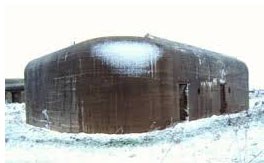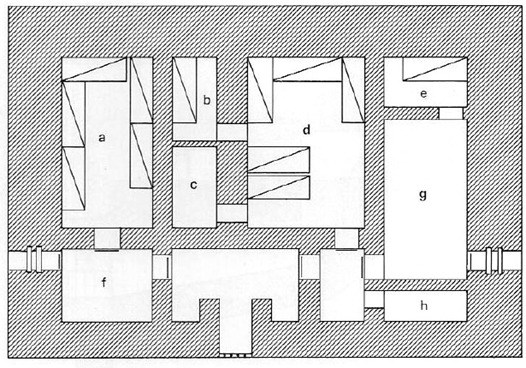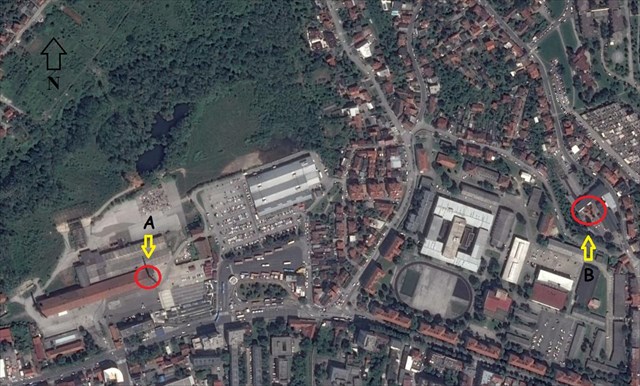 |
Because this is/was a military bunker, the cache is hidden in an appropriate way.
Initial coordinates are irrelevant in this cache. |

Search for the cache will take you to one of the bunker presented in the introduction/briefing. This is a Regelbau B Series L400 (communications and anti-aircraft bunker) located in the city neighborhood Crnomerec and it is the largest bunker in the City of Zagreb. Bunker was destroyed in year 1945. during the retreat of the German army in a World War II.
Bunker is located in a wetland area surrounded by two lakes, large (1-15 meters deep) and small one (2-3 meters deep).
Because this is/was a millitary bunker. This cache will put you in the role of a team leader of a small reconnaissance group that must work, think and manage in an unfamiliar and hostile environment to execute a specific task.
You will need!!: waterproof shoes, flashlight, pen, pice of paper and a friend!! And remember safety comes first!

Briefing:
The Regelbau was a standardized bunker built by the Germans in the Siegfried Line (German: Westwall) and the Atlantic Wall as part of their defensive fortifications prior to and during the Second World War.  The term is German and means "standard design" and standardization was truly the name of the game with close to 700 individual bunker types in the book at the end of the war, each with a specific task and identified by a unique number. This approach to fortifications allowed the contractor, Organisation Todt (OT) quickly to adapt any stronghold or fortified area to meet local conditions, strategic, tactical and geographical and to expand existing facilities without compromising the integrity.
The term is German and means "standard design" and standardization was truly the name of the game with close to 700 individual bunker types in the book at the end of the war, each with a specific task and identified by a unique number. This approach to fortifications allowed the contractor, Organisation Todt (OT) quickly to adapt any stronghold or fortified area to meet local conditions, strategic, tactical and geographical and to expand existing facilities without compromising the integrity.
The comparison to a standard house is only valid however, as to the repeated use of standardized elements. Apart from that a Regelbau bunker looks nothing like your everyday gazebo, and most prominently is the huge dimensions of walls and roof.
There were several advantages to standardizing the design and construction:
- Retention of proven design features when building new bunkers,
- Simpler manufacture of large quantities e.g. of armoured and ventilation components and simplified ordering from the industrial manufacturers involved,
- Easier surveying of construction sites with regard to the strategic situation,
- Simplified construction process,
- Easier supply of materials to the construction site

Apart from wall thickness, Regelbau bunkers share a series of similar features:
Entrance. If at all possible, the entrance ends in a 90° turn, covered by an embrasure for small-arms firing, protected by a 30 mm steel plate. Fighting posts (where the crew remains inside during combat, as i.e. in a radar-bunker) are further protected by a flanking gun embrasure providing enfilade fire along the entrance side. This is referred to as the close-combat room.
Gutters.This is a later addition to the basic design. Keeping rain water from entering doorways, air intakes and gun embrasures, these gutters also guided burning flame-thrower fuel away.
Doors. The standard door is a 30 mm thick armored steel door of the stable-door type. It can have rounded or square corners. Some types have man holes. A rubber sealing round the rim of the door makes it gas-tight. The inner door in a Regelbau bunker are often thin steel doors, but can also be wooden doors.
Room dividers. The size of a Regelbau bunker as well as the number and dispersion of rooms is strictly determined by it's function. Only the required rooms are present and no room is larger tahn absolutely necessary. Internal walls could be cast in concrete or laid in bricks or even wood.
Wall lining. In general, internal walls were lined with wood, partly because of the insulating effect, but also to minimize the effect of concrete blow-off caused by a direct hit on the outside. In later constructions, steel netting was applied in the casting process to improve the latter.
Flooring. In some bunkers you will find a flooring of (usually brown) asphalt tiles. These served as vibration dampers to counter the effects of shelling and bombardment that otherwise cause severe bodily injury to the inhabitants such as factures and damage to internal organs. In many bunkers you will se a warning against just that painted on the walls.
Gas protection. War-gasses being one of the weapons of mass destruction of WW1, most Regelbau bunkers - including all habitats and fighting posts - were secured against chemical warfare with air-tight doors, an airlock, pressure valves, armored air intakes and a air-purification device that could be either electrically or manually driven. The device created a higher pressure inside the bunker thus effectively preventing gas to slip through gaps in e.g. gun embrasures etc. Internal pressure was aligned by the valves.
Close-combat room. This is an ancient detail, used since the medieval; the flanking position to provide enfilade fire along the walls of the "fortress". Usually the gun embrasure is shaped as an inverted step-pyramid and lined with wood to prevent ricochet bullets from entering the bunker.
Well. Some bunkers have their own well, either right outside or inside the bunker. Today this may just appear as a rather deep - and not necessarily covered - hole in the floor, so mind your step!
Antenna. In many bunkers a carving in the concrete wall just outside the armored door can be observed, and in some even a metal fixture has survived. The carving leads to a hole in the ceiling and is designed to lead a segmented, telescopic radio antenna through the roof of the bunker.
Emergency exit. Bunkers with just one entrance often feature an emergency exit. Today this is most often just a hole in the wall, but you can be lucky, as the photo to the right demonstrates, to find an intact exit, complete with metal bars, brick wall and a gravel-filled stepladder tunnel.
Telephone. Used for communication between bunkers and HQ. Often bears the warning; "Achtung - Feind hort mit!" - Caution, the enemy is listening!
Voice-pipe. For communication between bunker an entrance or the look-out in the Tobruk (see below). A simple and reliable, non-electric system as it is also known on vintage ships.
Heating. All bunkers where the crew had to stay for a prolonged period of time had heating. In larger facilities a form of central heating was quite often used, but in it's form, heating was provided by an oven, using coal or wood as fuel, and with or without a boiler plate for cooking. The chimney pipe was constructed with a trap, leading a hand grenade dumped into the chimney to the outside of the bunker.
Periscope. In some bunkers, e.g. crew bunkers and fighting posts, you will observe a circular, 5 inch aperture in the steel ceiling. This is designed for a retractable u-boat style periscope, enabling the inhabitants to take a 360° peek of the area outside before opening the door. As so much other bunker equipment, periscopes have long vanished from rural bunkers, but working specimens kan be found i.e. at Aalborg Forsvars- og Garnisionsmuseum and at Silkeborg Bunkermuseum.
Toilet. Most often just a bucket with a seat, and placed in the airlock (most suitable, one might argue). In some cases a regular "outhouse" was constructed. Larger command bunkers had internal facilities.
Warnings and other works of art. The lucky bunker explorer might occasionally stumble over inscriptions or pictures, written or painted on bunker walls. In most cases it will be instructions or warnings, but it may also be Nazi insignia, enflaming paroles of courage or even artistic attempts by homesick soldiers to depict sceneries from home or a loved one left behind. Take all the photos you want, but do not disturb or destroy these messages from a sinister past.
Armored copulas. These are found on artillery observation posts, on certain mortar bunkers and in specialized machine-gun or anti-tank gun emplacements.

Mission: Allied forces intercepted the encrypted message sent from the bunker by an unknown source, which is critical for finding this cache. Immediate action is required.

Your task is to choose a team, because this is not an adventure for one person!, locate the bunker, infiltrate the environment, extract key information, locate a hidden object and pullout unseen.
Your objective is:
-
Find the location of bunker in a hostile and wetland area. With our air surveillance we managed to get area photo. But there was a failure on the drone and data were corrupted, we where able to extract only directions, the accurate position of the bunker you will have to figure out from the ground.
Data shows tall chimney, analysts says that this chimney is a part of an old brickyard in Crnomerec. From this point it is 356°. On the air photo as you can see it is marked as A.
Second data, marked as B, is a church tower 281°. I know it is not much but it will have to do, time is closing on us.
How to get there!? Unfortunately you'll have to manage on your own, our resources are limited. Keep in mind this is a wetland area and caution is recommended.

-
Inside, find the communication room. At a briefing you're familiar with all the features and details of the bunker Regelbau, so from this point orienteering in the bunker would not be a problem.
A few years ago, our spies have managed to get a photography of the communication room. Photo it could be of help.
-
The key part, locate a decryption machine and decypher the message. Over our confidential channels, we find out that decryption machine is hidden in one of the walls of the room, probably some kind a hole. Unfortunately, this is all the details we have, type of decryption machine unknown. Sweep the room very carefully.
-
Locate mystery object. When and if you decypher a message correctly (Check your solution), be extremely cautious, the ground is slippery and pointy. And others can be on your tail.
-
Extraction point. Unfortunately you'll have to manage on your own. This is the covered mission and we can not risk someone being seen. You're going to be fine, you're trained for this!
As always, should you or any of your team be seen to take and/or return the cache in place, the owner of this cache will disavow any knowledge of your actions.
Good luck!

Banner of glory for your page!
Code: <a href="http://coord.info/GC58N1D" target=_blank><img src="http://imgcdn.geocaching.com/cache/large/b8b5b549-b489-42cc-b9ae-c0074e21f1cd.png" /></a>
